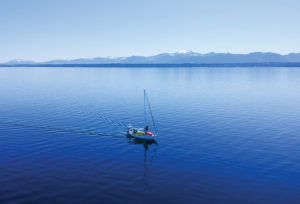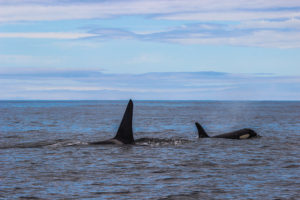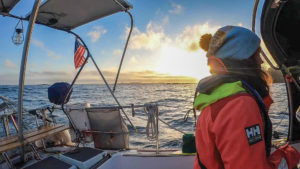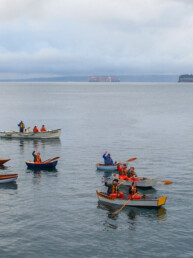This article was originally published in the January 2022 issue of 48° North.
The following is a story about cruising… more specifically, how COVID-19 completely and unexpectedly changed our cruising plans for the better.

Throughout several splendid summers of cruising in British Columbia, my wife, Jenny, and I set our sights on sailing our 1980 Alberg 37, Maya, from Washington to Mexico. After a couple years of postponing those plans — mostly due to our lack of cruising experience — we finally felt like we were ready to make the voyage south in the fall of 2020.
Unfortunately, when 2020 arrived, so too did the global pandemic. The craziness and uncertainty of the whole situation caused our southbound plans to evaporate. Instead, we spent 2020 in Anacortes continuing to work and prepare the boat for a departure to Mexico in 2021.
Then, at some point in that first year of the pandemic, an idea took shape. Instead of waiting all summer to sail south with the Coho HoHo fleet, why not spend the summer cruising in Alaska before heading down the coast to Mexico in the fall? Brilliant! And with that, we switched gears and started prepping for the northward journey through the Inside Passage to Southeast Alaska for a summer of exploring “The Last Frontier.” This would be our first time to Alaska, and our biggest adventure to date with Maya. Our previous summer voyages had taken us to Desolation Sound, the Broughtons, and even a circumnavigation of Vancouver Island. We loved every bit of our BC cruising experiences. Now, Alaska was in our sights.

After much preparation, on a beautiful sunny day in April, we shoved off the dock, giving up our slip and starting what would be our greatest adventure: first a 700 mile trip through British. There was one slight problem, though. The Canadian/US Border had been officially closed for a year and we needed to transit through British Columbia waters in order to reach Alaska. In April 2021, the initial shock of the pandemic had worn off slightly and a new seemingly pseudo-reality had set in. There were talks of the US/Canadian Border reopening, but that was on a month-by-month basis, and they kept extending it.
On our launch date, the border was definitely still closed, but there was a gray area of that closure for boats transiting through Canada to get to Alaska (and vice versa). Like any good cruiser, we did our homework but we didn’t find any concrete evidence to support that cruisers were absolutely guaranteed transit through BC enroute to Alaska.
We had heard reports of some cruisers being let through, while others were turned away. It was a fact that terrified us. Our research seemed to indicate that it boiled down to the onsite border agent’s discretion when we arrived. Attempts at calling the border agency were shot down by them explaining we needed to call no more than two hours in advance of our arrival into Canada. Our voyage’s fate would be decided on the spot. Frustrated, yet undeterred, we headed over to Sidney on Vancouver Island and awaited our fate.
Arriving at the dock, we called the customs phone number and the operator arranged for two border agents to meet us. We were greeted by two very polite agents, both equipped with bulletproof vests, and facemasks. They asked us why we were coming into Canada, to which we explained our plans were to transit through to Alaska and that Maya was our full-time residence. Upon hearing the news that Maya was our home, a noticeable change came over the agents — both of their dispositions seemed to relax. Maya being our “full-time residence” seemed to be the magic phrase.

After discovering that we were “moving our house” to Alaska, the agents carried on with necessary paperwork. First, attesting that we didn’t have COVID symptoms or had been in contact with anyone with symptoms. After they got a sense that we weren’t actively sick from COVID, they proceeded with heavy interrogation regarding guns.
“Do you have any guns aboard?”
“No.”
“Have you ever owned a gun before?”
“No.”
“Have you ever shot a gun before?”
“Yes.”
“Are you sure you don’t have any guns aboard? It’s better to tell us now before we find them ourselves.”
“I’m positive we don’t have any guns aboard.”
After questioning, they had us stand on the dock while they entered the boat and gave it a thorough search (for the guns they were sure we had aboard), and after 15 minutes they reemerged from Maya, empty handed.

At this point, the conversation shifted to our itinerary to Alaska. Our planned passage was to be a 14 day route (43 mile per day average) with us anchoring each night. They approved this plan, but warned us not to make any “unnecessary sightseeing detours.”
The agents also explained that we were allowed to stop at fuel docks for fuel or water and marinas should safety or weather become a concern, but we were to remain quarantined. And after more paperwork and instructions, we were given an orange piece of paper with a number on it, granting us passage through Canadian waters without being officially checked into the country. While the ticket was orange, it felt golden.
We thanked them for their help and with a huge sigh of relief we pushed off the customs dock and motored to Montague Harbour where we dropped the hook for the night. We were officially through the trip’s first major challenge: crossing a closed international border during a global pandemic. Our cruising plans were alive and well — with only 600 miles to go to Alaska.
The next morning we moved on, passing Dodd Narrows, and anchoring in Mark Bay outside of Nanaimo. In normal years, upon arriving in Nanaimo, we would have spent the day exploring Newcastle Island, followed by a beer at the Dinghy Dock Pub. Alas, it was not to be. Rules were rules and we were thankful to be there… just passing through. And passing through is what we did.
We raced up to Campbell River, through Johnstone Strait arriving in Port McNeill without seeing another American boat or a cloud in the sky for that matter. We had gotten extremely lucky with the weather, especially considering it was mid April in the Pacific Northwest. At Port McNeill, we briefly stopped at the dock to refuel on diesel and fill up our water tanks. We wore masks, so did the attendant. While heading to the office to pay, we chatted with the attendant about the weather and how little traffic there was due to the border closure, but besides the masks, it was a totally normal fuel dock experience.
We anchored outside of Port McNeill that night and then motored towards the top of Vancouver Island. It was only then, as we arrived on the southside of Queen Charlotte Strait, that our fair weather gave out, forcing us to spend several nights in Clam Cove — a small inlet on the northside of Nigei Island.
Our time there was spent listening to our anchor chain scrape across the rocky bottom as we looked at derelict sinking boats at one end of the bay while keeping an eye out for horror movie serial killers in a rundown (also sinking) floating resort at the other. Not a soul to be seen around. There were also martinis, if I recall correctly.

After the storm, we wound our way (gleefully, I should add) out of the snaking entrance to Clam Cove and made the jump across Queen Charlotte Strait. The sea state was a little messy from the storm but after a long, rolly day we were through Cape Caution and arrived in Fury Cove on Penrose Island.
By this point, the weather forecast was showing a major storm in the coming days. Armed with this knowledge, we decided to race as quickly as we could to Prince Rupert, where we planned to hunker down in quarantine with the glories of cell reception. Over the next three days, we covered 227 nautical miles arriving in Prince Rupert just as the last bit of sunlight was fading from the sky. Hours later, the wind picked up and, to our great disappointment, we were slammed with waves. Unfortunately, the one exposed direction of our anchorage in Pillsbury Cove was the same direction the wind was blowing from. We endured the waves and kept a keen eye on the lee shore a few hundred yards away. Fortunately, our Rocna 20 anchor held strong. Our patience paid off and after 24 hours the wind let up enough for us to zip over to Cow Bay Marina.
At the marina, we were warmly welcomed by the harbormaster and spent the next two days waiting for the storm to pass — all the while finding new leaks in our boat (the storm would bring a total of 6 inches over three days). After the storm passed, we had a very gray and misty, but otherwise uneventful, passage across the notorious Dixon Entrance to Foggy Bay, which concluded our cruise through British Columbia — global pandemic edition. We’d done it!
Now in Alaska, we spent the next two and a half months exploring this amazing cruising destination before turning south and returning to Washington on a non-stop, 6 day passage from Craig, Alaska to Neah Bay, Washington… but all of that is a story for another time.
At the time of this writing, it’s been roughly 7 months since launching from Anacortes and Maya is currently in San Diego making final preparations before heading into Mexico.

Reflecting back on our trip through Canada, and the uncertainty of the border closure, I can’t help but recognize what a great example of real world cruising that was. We had a plan, there were complications, we researched and prepared as much as possible, but at some point, without being positive of the outcome, we pressed on — choosing to deal with and adapt to whatever situation arose.
That’s cruising in a nutshell. And while that area of “uncertainty” is not comfortable, neither is cruising all the time. It’s that unknown and discomfort that allows for those brilliant and beautiful moments. The exhilaration and excitement we experienced of just being allowed to pass through Canada was only because we went and faced that uncertainty head on.
The script was being written right then and there, and that’s what we love about cruising. On the water, you are writing your story each and every day. And when you think about it, who wants to read a book where you already know the ending?






